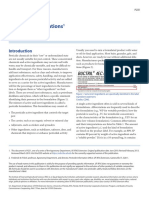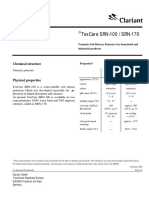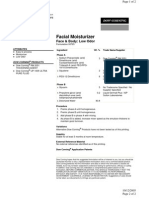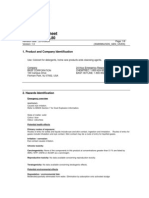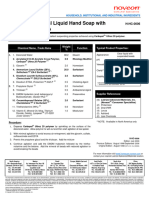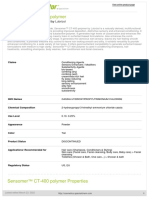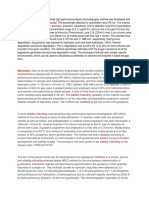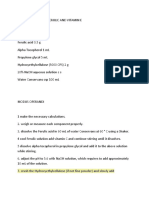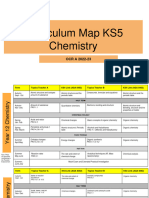HLB
HLB
Uploaded by
Jai Murugesh0 ratings0% found this document useful (0 votes)
445 views5 pagesThis document discusses key aspects of formulating cosmetic products including:
1. Tracking raw materials used including name, code, percentage in formula, batch size, amounts added, and observations during production.
2. Common types of ingredients used in cosmetics like silicones, polymers, and natural ingredients.
3. Key considerations for creating stable emulsions including calculating the required HLB of oil phases and surfactants, and using emulsifiers to overcome tension between phases.
Original Description:
Copyright
© © All Rights Reserved
Available Formats
DOCX, PDF, TXT or read online from Scribd
Share this document
Did you find this document useful?
Is this content inappropriate?
Report this DocumentThis document discusses key aspects of formulating cosmetic products including:
1. Tracking raw materials used including name, code, percentage in formula, batch size, amounts added, and observations during production.
2. Common types of ingredients used in cosmetics like silicones, polymers, and natural ingredients.
3. Key considerations for creating stable emulsions including calculating the required HLB of oil phases and surfactants, and using emulsifiers to overcome tension between phases.
Copyright:
© All Rights Reserved
Available Formats
Download as DOCX, PDF, TXT or read online from Scribd
Download as docx, pdf, or txt
0 ratings0% found this document useful (0 votes)
445 views5 pagesHLB
HLB
Uploaded by
Jai MurugeshThis document discusses key aspects of formulating cosmetic products including:
1. Tracking raw materials used including name, code, percentage in formula, batch size, amounts added, and observations during production.
2. Common types of ingredients used in cosmetics like silicones, polymers, and natural ingredients.
3. Key considerations for creating stable emulsions including calculating the required HLB of oil phases and surfactants, and using emulsifiers to overcome tension between phases.
Copyright:
© All Rights Reserved
Available Formats
Download as DOCX, PDF, TXT or read online from Scribd
Download as docx, pdf, or txt
You are on page 1of 5
Raw material names (trade name or INCI name when possible)
Raw material tracking code / lot number
Percent required for the formula
Batch size and amount of raw materials required
Amount of raw materials actually added
Time ingredients are added
Temperature of addition
Observation of what happens to the batch while youre making it
Silicones
For silicone containing materials, terms like Dimethicone, Cyclomethicone and
amodimethicone are used. Whenever you see some form of these words in a chemical
name, you know there is some silicone in it.
PEG is Polyethylene Glycol. PPG is Polypropylene Glycol, etc. Then a number is included to
refer to the moles of ethoxylation in the polymer.
Common Names
When they first came up with the INCI (originally called the CTFA Cosmetic Ingredient
Dictionary) in 1973, many cosmetic ingredients already had names. These common
names were incorporated into the dictionary even though they didnt follow any specific
naming rules. Therefore, we use Glycerin instead of the more accurate Glycerol and
Menthol instead of (1R, 2S, 5R)-2-isopropyl-5-methylcyclohexanol. Common names are
also used for various natural ingredients like Lanolin and Beeswax.
1. The function raw materials
2. The performance effect of raw materials
3. The formula effect of raw materials
The first thing to know about cosmetic ingredients is the ingredient list. In the United States,
every personal care and cosmetic product is supposed to have their ingredients listed. In the
business, we called it the LOI (list of ingredients). Any ingredient above 1% is required to be
listed in order of concentration (by weight). At 1% or below, the ingredients can be listed in any
order. Typically, preservatives and dyes are listed at the end. In a future post, well show how
this labeling requirement can help you formulate new products.
Calculation of required HLB for an oil phase mixture
The oil phase is 10% of the total formulation and consists of:
4% Shea butter, 40% of the oil phase. Reqd HLB of 8.
3% Jojoba oil, 30% of the oil phase. Reqd HLB of 6.5.
3% Sunflower seed oil, 30% of the oil phase. Reqd HLB of 7.
Total required HLB:
Shea butter contribution 0.4 x 8 = 3.20
Jojoba oil contribution 0.3 x 6.5 = 1.95
Sunflower oil contribution 0.3 x 7 = 2.10
Total Reqd HLB = 7.25
You can now select emulsifiers to match the required HLB of the oil
phase and create an emulsion. A blend of high and low HLB
surfactants is often used to achieve the desired value in part
because of demonstrated effectiveness and efficiencies in packing
at the interface. The HLB for the surfactant blend is calculated in
same manner as the required HDetermining the HLB of a surfactant
A typical nonionic emulsifier (e.g. Laureth-4) contains an ethylene oxide groups or
polyhydric alcohol hydrophilic portions with a fatty alcohol hydrophobic portion. The
HLB for a nonionic surfactant can be calculated as follows:
HLB = Weight % Hydrophile/5
Example 1: HLB calculation for Laureth-4
Molecular weight of ethoxylate portion = 176
Molecular weight of lauryl alcohol = 186
Wt. % Hydrophile = (176/(176+186)) x 100 = 48.6%
HLB = 48.6/5 = 9.7
Based on the calculation, surfactants with high HLB values will be more water soluble
and those with low HLB values are more oil soluble. Division by 5 just allows for a
compact, easy to use scale. The calculation is simple, but you wont usually have to
figure it out since most surfactant HLB values are readily available through literature
references and surfactant suppliers.
LB for a blend.
Calculating HLB of oil phase
Each lipophilic ingredient in the oil phase has its own required HLB. These required
HLB values are determined experimentally, however a method utilizing solubility
parameters has been proposed by Vaughan and Rice.
2
Required HLB values for some
common oil phase ingredients are available to the formulator in literature. The Reqd
HLB values are approximate and can vary by about 1 unit. It is also important to keep
in mind that cosmetic emulsions often have complex oil phases with several
components. The required HLB of an oil phase mixture can be calculated by first
calculating the percent of the oil phase each ingredient contributes. This percentage is
then multiplied by the required HLB for each of those ingredients and the results are
summed.
Determining the HLB of a surfactant
A typical nonionic emulsifier (e.g. Laureth-4) contains an ethylene oxide groups or
polyhydric alcohol hydrophilic portions with a fatty alcohol hydrophobic portion. The
HLB for a nonionic surfactant can be calculated as follows:
HLB = Weight % Hydrophile/5
Cosmetic Emulsions
Emulsions are one of the most common forms of cosmetic products. You find them in
skin lotions, make-up, and even hair products. By definition an emulsion is a dispersion
of two or more immiscible materials, where one phase, also know as the internal phase,
is dispersed in the continuous or external phase. Cosmetic emulsions are classified as oil
in water (O/W), water in oil (W/O) and water in silicone (W/Si). Multiple emulsions
such as oil in water in oil (W/O/W) are also possible. Oil in water emulsions are the
most common due to preferable cost and light skin feel.
In order to create an oil in water emulsion (one that remains stable for a long enough
time), work must be done to overcome the interfacial tension between the two phases.
This can be achieved by mixing; however mixing even at very high rates is not enough to
provide long term stability. An emulsifier or combination of emulsifiers is needed to
stabilize droplets of the dispersed phase. For example, simple oil in vinegar salad
dressings will separate rapidly without the use of an emulsifier like mustard.
* Thickeners to modify the viscosity of a formula
* Formula Stabilizer to help keep emulsions stable
* Conditioning agents to improve the surfaces of hair and skin
* Opacifying agents to make formulas look more luxurious
* Preservative to prevent microbial growth
* Occlusive agents to help moisturize skin
* Styling agents to hold hair styles in place
* Conditioning agents to improve the surfaces of hair and skin
* Opacifying agents to make formulas look more luxurious
* Shine agents to increase hair shine and give gloss to skin
* Defoaming agents to reduce foam in cleansing formulas
* Occlusive agents to help moisturize skin
* Slip agents to help skin formulas spread more easily
* Hair detangling agents to make hair easier to comb
Fatty acids are the basis for many of the surfactants used in cosmetic products
Lauric Acid, Palmitic Acid, Oleic Acid, Stearic Acid, Behenic Acid
the most common emulsions are ones in which oil is dispersed in water. To create emulsions,
typically a surfactant is also used. Emulsions are delivery systems for beneficial cosmetic
ingredients. These ingredients are often incompatible with water and have undesirable aesthetic
characteristics by themselves. The ingredients are mixed with water to create creams or lotions.
Detergents for cleansing
* Wetting agents for helping formulas spread more easily
* Foaming agents to produce consumer friendly suds
* Emulsifiers to create stable mixtures of oil and water
* Conditioning agents to improve the surfaces of hair and skin
* Solubilizers to help mix fragrances into water-based formulas
* Preservatives to keep cosmetics microbe-free
* Special Effects to improve the look of certain formulas
Surfactant is a shorter way to say surface active agent. These are molecules that have
the property of reducing surface tension, thereby allowing oil and water to form stable
(temporarily) mixtures.
Examples Sodium Lauryl Sulfate, Cocamidopropyl Betaine, Glycol Distearate,
Ammonium Laureth Sulfate, Polysorbate 80
You might also like
- Formulation of Paracetamol SyrupDocument2 pagesFormulation of Paracetamol SyrupJai Murugesh91% (22)
- HLB - The Easiest Way To Create An Emulsion: Cosmetic EmulsionsDocument24 pagesHLB - The Easiest Way To Create An Emulsion: Cosmetic EmulsionsVeliYunusKavalciNo ratings yet
- HLB SystemDocument37 pagesHLB SystemNeha DandNo ratings yet
- Brochure PAP SolvayDocument24 pagesBrochure PAP Solvaysrushti100% (2)
- Emulsifiers&StabilizersDocument6 pagesEmulsifiers&StabilizerscastimaxNo ratings yet
- EmulsifiantiDocument20 pagesEmulsifiantiAlexandra AlexyaNo ratings yet
- Bio Surfactants and Synthetic Variants Used in Herbal Face Wash A ReviewDocument6 pagesBio Surfactants and Synthetic Variants Used in Herbal Face Wash A ReviewP. SathammaiNo ratings yet
- Safety Data Sheet Crodasinic HT: 1. Identification of The Substance/Preparation and of The Company/UndertakingDocument5 pagesSafety Data Sheet Crodasinic HT: 1. Identification of The Substance/Preparation and of The Company/UndertakingIvanNo ratings yet
- Raw Material LipstickDocument4 pagesRaw Material LipstickSalsabila P Wahyudin100% (1)
- Brochure Miracare SLBDocument12 pagesBrochure Miracare SLBvalkira1100% (1)
- Book The HLB System ICIDocument22 pagesBook The HLB System ICIAnkit GoyalNo ratings yet
- 27 1897 01 After Shave Wipe Formulation 00510Document2 pages27 1897 01 After Shave Wipe Formulation 00510Rene HernandezNo ratings yet
- Propylene Carbonate at Dow ChemicalsDocument6 pagesPropylene Carbonate at Dow Chemicalsjangri1098No ratings yet
- HLB Calculator FacebookDocument5 pagesHLB Calculator FacebookcatalinNo ratings yet
- Pesticide FormulationDocument13 pagesPesticide FormulationMalappa MamadapureNo ratings yet
- Stepan Formulation 1204Document2 pagesStepan Formulation 1204ricardo navarreteNo ratings yet
- Mosselman Lubricant IngredientsDocument8 pagesMosselman Lubricant Ingredientsmilitiamon100% (1)
- Croda Emulsions Brochure WEBDocument24 pagesCroda Emulsions Brochure WEBSantos GarciaNo ratings yet
- SH 0093 (Eu) PDFDocument1 pageSH 0093 (Eu) PDFRani RubiyantiNo ratings yet
- TexCare SRN 100 and 170Document4 pagesTexCare SRN 100 and 170Nikesh Shah100% (1)
- Cremophor® RH 40 Product Details: Soluble in Essential OilsDocument2 pagesCremophor® RH 40 Product Details: Soluble in Essential OilsJai MurugeshNo ratings yet
- E32571b7d999 150707023352 Lva1 App6891Document24 pagesE32571b7d999 150707023352 Lva1 App6891mahmoud akermi100% (1)
- Tagra+ +Pandemic+BeautyDocument7 pagesTagra+ +Pandemic+BeautyKirk BorromeoNo ratings yet
- FORMUL - 00795 Low Odor Face & BodyDocument2 pagesFORMUL - 00795 Low Odor Face & BodyDarrenGilbertNo ratings yet
- DS HyaCare 50 eDocument5 pagesDS HyaCare 50 eAnwar LdNo ratings yet
- WS SA50™ Anti-Dandruff - Scalp Teliever - Ácido Salicílico 4%Document2 pagesWS SA50™ Anti-Dandruff - Scalp Teliever - Ácido Salicílico 4%allanHFNo ratings yet
- Cithrol™ PGTL: Discover Effortless PerformanceDocument15 pagesCithrol™ PGTL: Discover Effortless PerformancesimmiNo ratings yet
- Kao Optimized Coacervation FormationDocument5 pagesKao Optimized Coacervation FormationQuỳnh-Mai Nguyễn100% (1)
- Why Does Salt Thicken ShampoosDocument2 pagesWhy Does Salt Thicken ShampoosSilah FerbulOusNo ratings yet
- Brij CS20Document8 pagesBrij CS20Yovani Huaquisaca CoaquiraNo ratings yet
- Biariq SLES 70% TDSDocument2 pagesBiariq SLES 70% TDSAbdullah AzzamNo ratings yet
- Oven Cleaner - 232Document1 pageOven Cleaner - 232mndmattNo ratings yet
- MSDS For OIL REMOVER-6104Document5 pagesMSDS For OIL REMOVER-6104Rocky Bis100% (1)
- Iragon Blue ABL80Document6 pagesIragon Blue ABL80maricarmen1986No ratings yet
- Stepan Formulation 1220Document2 pagesStepan Formulation 1220Devesh KumarNo ratings yet
- 6 Sepawa-Nordic 1516 May EOC Surfactants FVDocument27 pages6 Sepawa-Nordic 1516 May EOC Surfactants FVmagdyNo ratings yet
- En TS 501221 PDFDocument1 pageEn TS 501221 PDFHéctor FabiánNo ratings yet
- Dow Surfactants: Reference ChartDocument8 pagesDow Surfactants: Reference ChartCerelia100% (1)
- Cosmetic Formulary A4 032017 LR - WaxDocument31 pagesCosmetic Formulary A4 032017 LR - WaxMohammad Mariasa100% (1)
- EvonikDocument20 pagesEvonikMohit Singhal0% (1)
- Hand Sanitizer Version 1 - 01.04.2020Document19 pagesHand Sanitizer Version 1 - 01.04.2020Heidy Roxana Lopez VelizNo ratings yet
- H-HC-0007 - Antibacterial Liquid Hand SoapDocument1 pageH-HC-0007 - Antibacterial Liquid Hand SoapWork ShareNo ratings yet
- Personal Care Product Range Latin America English VersionDocument8 pagesPersonal Care Product Range Latin America English VersionAlfonso PeñarandaNo ratings yet
- The HLB System The HLB SystemDocument30 pagesThe HLB System The HLB SystemSesiones TradingNo ratings yet
- Analysis of Emulsifiers: Prafulla Kumar Sahu Alliance Institute of Advanced Pharmaceutical and Health SciencesDocument30 pagesAnalysis of Emulsifiers: Prafulla Kumar Sahu Alliance Institute of Advanced Pharmaceutical and Health Scienceskunasahu1No ratings yet
- H-HC-0006 - Clear Liquid Hand SoapDocument1 pageH-HC-0006 - Clear Liquid Hand SoapWork ShareNo ratings yet
- Sensomer™ CT-400 Polymer - LubrizolDocument2 pagesSensomer™ CT-400 Polymer - LubrizolCaroline DettogniNo ratings yet
- Increase Product Quality For A Car-Wash Shampoo ConcentrateDocument6 pagesIncrease Product Quality For A Car-Wash Shampoo ConcentraterezaNo ratings yet
- Formulation Guideline ChiaDocument15 pagesFormulation Guideline Chianational biopureNo ratings yet
- Stepan Formulation 149Document2 pagesStepan Formulation 149Jignesh PadhiyarNo ratings yet
- 100% Bio-Based Acidic Bathroom Cleaner Hc/Hs/111 With Eco Natrasense™ 265Document1 page100% Bio-Based Acidic Bathroom Cleaner Hc/Hs/111 With Eco Natrasense™ 265TinasheNo ratings yet
- Stepan Formulation 1036Document2 pagesStepan Formulation 1036Muhammad ZubairNo ratings yet
- . "Unlocking the Secrets of Beauty: A Guide to Cosmetics" "The Science Behind the Glamour: An Insight into the World of Cosmetics"From Everand. "Unlocking the Secrets of Beauty: A Guide to Cosmetics" "The Science Behind the Glamour: An Insight into the World of Cosmetics"No ratings yet
- The Iron Oxides: Structure, Properties, Reactions, Occurrences and UsesFrom EverandThe Iron Oxides: Structure, Properties, Reactions, Occurrences and UsesRating: 5 out of 5 stars5/5 (1)
- Surface Chemistry of Surfactants and PolymersFrom EverandSurface Chemistry of Surfactants and PolymersRating: 5 out of 5 stars5/5 (1)
- Cleaning and disinfection of food factories: a practical guideFrom EverandCleaning and disinfection of food factories: a practical guideNo ratings yet
- Handbook of Vinyl FormulatingFrom EverandHandbook of Vinyl FormulatingRichard F GrossmanRating: 3 out of 5 stars3/5 (1)
- A DIY Guide to Therapeutic Skin Care Natural Recipes: Glowing Skin Naturally: A Step-by-Step Guide on How to Make Cleansers, Toners, Moisturizers, and More from Whole Natural IngredientsFrom EverandA DIY Guide to Therapeutic Skin Care Natural Recipes: Glowing Skin Naturally: A Step-by-Step Guide on How to Make Cleansers, Toners, Moisturizers, and More from Whole Natural IngredientsNo ratings yet
- Ketoconazole Cream Clinical ParticularsDocument2 pagesKetoconazole Cream Clinical ParticularsJai MurugeshNo ratings yet
- Table 5: Indicative Categories and Chemical Ingredients of Cosmetic ProductsDocument1 pageTable 5: Indicative Categories and Chemical Ingredients of Cosmetic ProductsJai MurugeshNo ratings yet
- Tablets of Potassium IodideDocument2 pagesTablets of Potassium IodideJai MurugeshNo ratings yet
- Ferulic AcidDocument5 pagesFerulic AcidJai MurugeshNo ratings yet
- IngredientsDocument15 pagesIngredientsJai MurugeshNo ratings yet
- MethodDocument3 pagesMethodJai MurugeshNo ratings yet
- Tablets of Potassium IodideDocument2 pagesTablets of Potassium IodideJai MurugeshNo ratings yet
- Water Based Personal Lubricant: Product DescriptionDocument1 pageWater Based Personal Lubricant: Product DescriptionJai MurugeshNo ratings yet
- Semisolids Manufacturing Consideration: 1) Flow DiagramDocument2 pagesSemisolids Manufacturing Consideration: 1) Flow DiagramJai MurugeshNo ratings yet
- S.N o Name of Raw Material Specification Quantity / Batch (In KGS)Document3 pagesS.N o Name of Raw Material Specification Quantity / Batch (In KGS)Jai MurugeshNo ratings yet
- Is It Possible To Use Multiple Batch Numbers in Packaging of Medicinal Products? H+V January 2005Document7 pagesIs It Possible To Use Multiple Batch Numbers in Packaging of Medicinal Products? H+V January 2005Jai MurugeshNo ratings yet
- Eye Drops PreparationDocument1 pageEye Drops PreparationJai MurugeshNo ratings yet
- CalculationsDocument46 pagesCalculationsJai MurugeshNo ratings yet
- Solubilty of DrugsDocument19 pagesSolubilty of DrugsJai MurugeshNo ratings yet
- Microbial Limit TestDocument29 pagesMicrobial Limit TestJai MurugeshNo ratings yet
- Mosquito RepellentDocument6 pagesMosquito RepellentJai MurugeshNo ratings yet
- P Chloro M XylenolDocument2 pagesP Chloro M XylenolJai MurugeshNo ratings yet
- Calcipotriol MonohydrateDocument1 pageCalcipotriol MonohydrateJai MurugeshNo ratings yet
- Crush The Hydroxyethylcellulose (If Not Fine Powder) and Slowly AddDocument2 pagesCrush The Hydroxyethylcellulose (If Not Fine Powder) and Slowly AddJai MurugeshNo ratings yet
- Performance Analysis of Atmospheric Water ExtractorDocument57 pagesPerformance Analysis of Atmospheric Water ExtractorAlex Pandian SNo ratings yet
- Manual For SP1 7890-0552 PDFDocument30 pagesManual For SP1 7890-0552 PDFvzimak2355No ratings yet
- Asdfghjkl GENERALCHEMDocument7 pagesAsdfghjkl GENERALCHEMfai hinchingNo ratings yet
- 363R 92Document93 pages363R 92DIDIER ANGEL LOPEZ RINCONNo ratings yet
- FabshieldXLR 8Document2 pagesFabshieldXLR 8Michael ClaphamNo ratings yet
- Fabrication and Properties of Zinc Oxide Thin FilmDocument6 pagesFabrication and Properties of Zinc Oxide Thin FilmLalu SuhaimiNo ratings yet
- ASTM A53 B Carbon Steel Pipes - Allowable PressureDocument8 pagesASTM A53 B Carbon Steel Pipes - Allowable PressureAizat Najib100% (1)
- MSA Global EU UK RoHS Declaration 09072022Document15 pagesMSA Global EU UK RoHS Declaration 09072022Felipe CarmonaNo ratings yet
- Conference Program ICE-SEAM 2022Document46 pagesConference Program ICE-SEAM 2022Kevin Lieus FelixNo ratings yet
- Nucleic Acids HandoutDocument3 pagesNucleic Acids HandoutAlifah SyarafinaNo ratings yet
- MSDS Hair PermDocument10 pagesMSDS Hair Permsabuyexpress.worldwideNo ratings yet
- Tutorial 7Document10 pagesTutorial 7Noble MathewsNo ratings yet
- KS5 Chemistry OCR A Curriculum Map 2022Document4 pagesKS5 Chemistry OCR A Curriculum Map 2022ghbydcqyf2No ratings yet
- RT Safety Sample QuestionsDocument2 pagesRT Safety Sample QuestionsSuresh SenanayakeNo ratings yet
- Biomass Production of Chlorella SP., Scenedesmus SP., and OscillatDocument11 pagesBiomass Production of Chlorella SP., Scenedesmus SP., and OscillatDavid HernándezNo ratings yet
- Pafix No1Document4 pagesPafix No1Dilip ThummarNo ratings yet
- LLDPE ProjectDocument86 pagesLLDPE Projectbhagwat2680% (5)
- Syllabus For Grade 9 Exams: Number SystemDocument12 pagesSyllabus For Grade 9 Exams: Number SystemJiwook NohNo ratings yet
- A Coupled Fluid Dynamic-Discrete Element Simulation of Heat and Mass Transfer in A Lime Shaft KilnDocument14 pagesA Coupled Fluid Dynamic-Discrete Element Simulation of Heat and Mass Transfer in A Lime Shaft KilnGuglielmo CancelliNo ratings yet
- Plasma MachiningDocument14 pagesPlasma MachiningMayankNo ratings yet
- Basic Hydraulic Fracturing PDFDocument51 pagesBasic Hydraulic Fracturing PDFhoangvubui4632100% (2)
- Ullmann TolueneDocument10 pagesUllmann Toluenenacho100% (1)
- Microporous and Mesoporous Materials: SciencedirectDocument8 pagesMicroporous and Mesoporous Materials: SciencedirectAssyakurNo ratings yet
- Risk Management Applied To Food Safety, Security and SanitationDocument5 pagesRisk Management Applied To Food Safety, Security and SanitationLea MaeNo ratings yet
- Ssef Facette 2013Document40 pagesSsef Facette 2013phtoostar_475335573No ratings yet
- Paints and VarnishesDocument58 pagesPaints and VarnishesMia ListaNo ratings yet
- FDA Guidance For Industry MDI and DPIDocument65 pagesFDA Guidance For Industry MDI and DPIOrest Lastow100% (1)
- R e A D 0750633654 Chemistry of The Elements Second EditionDocument12 pagesR e A D 0750633654 Chemistry of The Elements Second EditionemreNo ratings yet
- Iupac RulesDocument19 pagesIupac Rulesaleena'100% (1)
- Port Size: 1/4" Iso G/NPT Suitable For Gas/liquid Applications Suitable For Tracking ApplicationsDocument4 pagesPort Size: 1/4" Iso G/NPT Suitable For Gas/liquid Applications Suitable For Tracking ApplicationsAmmar KhaleelNo ratings yet














